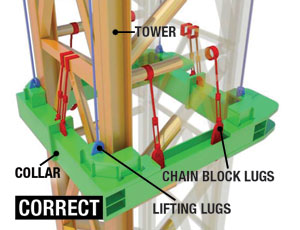Seven lives would have been spared if William Rapetti, the master rigger in charge of the Midtown Manhattan tower crane that collapsed on March 15, 2008, had followed the manufacturer’s instructions, investigators say.
A 250-page report, prepared by Arup on behalf of the city’s Dept. of Buildings and released on March 11, tells the story of how decisions made during the routine jump of a Favelle Favco M440E crane led to disaster. Rapetti, who faces civil and criminal charges, says he is not guilty.


The crew used four fewer attachment points than the eight specified by the manufacturer. One sling was damaged, and all were rigged improperly (see left). The synthetic slings’ angle led to an unorthodox choker, decreasing holding capacity and exposing them to sharp edges. Loud, snapping sounds were heard.
Those noises were soon followed by the roar of an 11,279-lb steel collar plummeting down the 200-ft-tall mast, smashing into two collars below and compromising the crane’s overturning resistance. The crane fell toward E. 51st St., killing seven people, including a civilian. It demolished a brownstone and damaged a dozen more buildings in its path.
The yearlong investigation “shows the consequences of taking shortcuts on the jobsite,” says Buildings Commisioner Robert LiMandri. The study was carried out alongside the Occupational Safety and Health Administration and is consistent with the federal agency’s findings.

Post a comment to this article
Report Abusive Comment